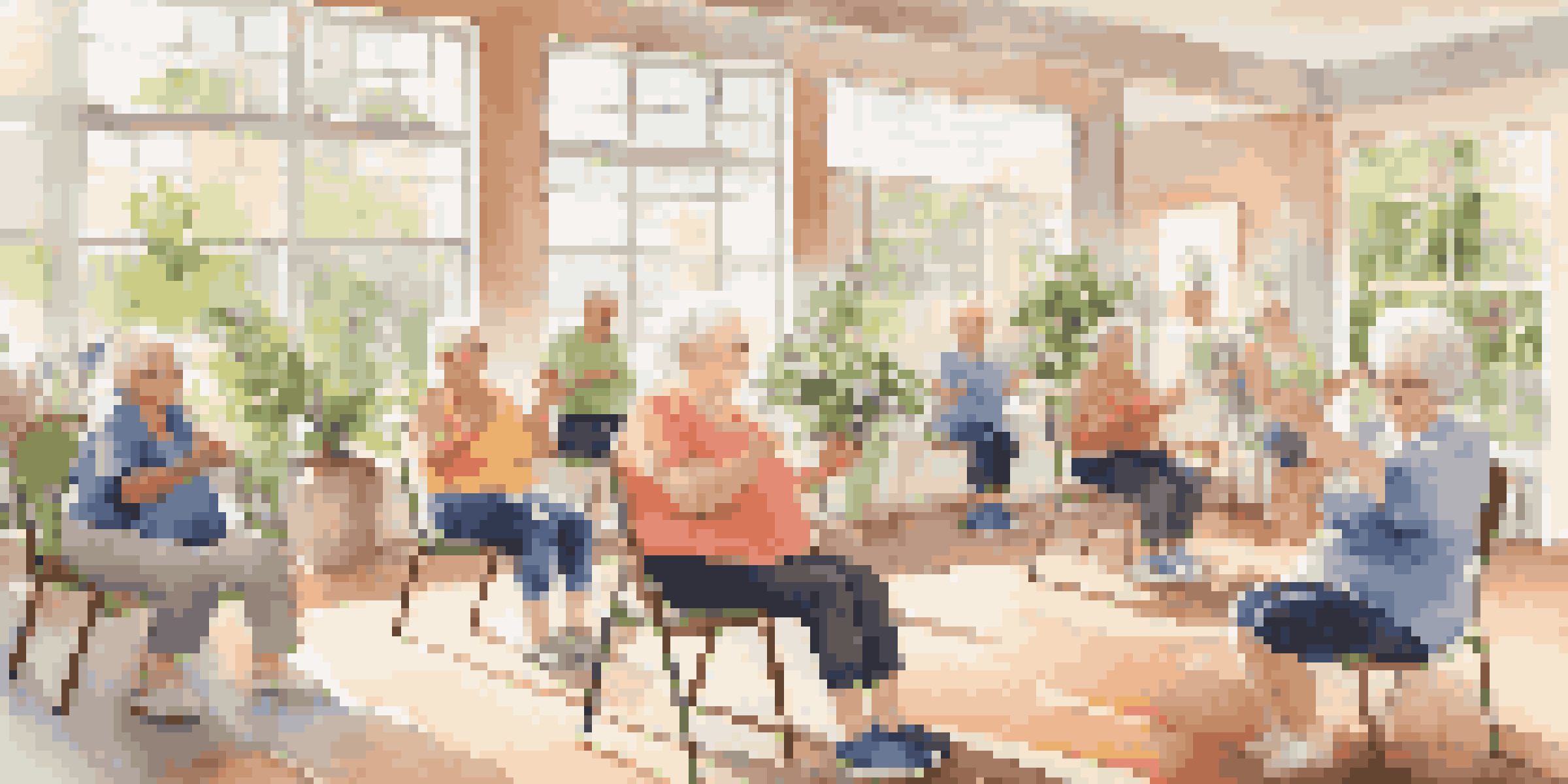Adaptive Fitness Techniques for Seniors and Disabled Individuals

Understanding Adaptive Fitness and Its Importance
Adaptive fitness refers to tailored exercise programs that accommodate the unique needs of seniors and individuals with disabilities. It focuses on enhancing mobility, strength, and overall well-being, ensuring that everyone can participate in physical activities safely. By recognizing the importance of adaptive fitness, we promote a more inclusive approach to health and wellness.
Exercise is a celebration of what your body can do. Not a punishment for what you ate.
Engaging in regular physical activity can significantly improve quality of life for seniors and disabled individuals. It helps in reducing the risk of chronic diseases, improving mental health, and boosting energy levels. Understanding these benefits is crucial for motivating individuals to embrace adaptive fitness techniques.
Moreover, adaptive fitness fosters a sense of community and belonging. When individuals participate in group activities or classes specifically designed for them, they often find companionship and support, making exercise a more enjoyable and fulfilling experience.
Types of Adaptive Fitness Techniques Available
Adaptive fitness techniques vary widely, offering options for everyone, regardless of their physical limitations. Some popular methods include chair exercises, water aerobics, and resistance band training. Each of these techniques can be modified to suit the individual’s capabilities and comfort levels.

For instance, chair exercises provide a safe way for those with limited mobility to engage in strength-building activities. Similarly, water aerobics offers buoyancy, which reduces the strain on joints while allowing for a full-body workout. Understanding these diverse techniques enables individuals to find the right fit for their fitness journey.
Benefits of Adaptive Fitness
Adaptive fitness enhances mobility, strength, and overall well-being for seniors and individuals with disabilities.
Additionally, incorporating flexibility and balance training is crucial for preventing falls and enhancing stability. Techniques such as tai chi or gentle yoga can help improve coordination and reduce the risk of injury, making them ideal choices for seniors and those with disabilities.
Safety Considerations When Exercising
Safety is paramount when it comes to adaptive fitness, especially for seniors and disabled individuals. It's essential to consult with healthcare professionals before starting any new exercise routine to ensure it aligns with personal health conditions. This step can help prevent injuries and promote a safe workout environment.
The greatest wealth is health.
Creating a comfortable workout space is equally important. This could mean using non-slip mats, having supportive chairs, or ensuring that equipment is accessible. A safe environment encourages individuals to focus on their movements without the fear of falling or injuring themselves.
Lastly, listening to the body is vital. Individuals should be encouraged to recognize their limits and adjust their routines accordingly. Pacing oneself and taking breaks when needed can help maintain a positive exercise experience.
Setting Realistic Fitness Goals
Setting realistic fitness goals is crucial for success in any adaptive fitness program. It’s important to start with small, achievable objectives to build confidence and momentum. For instance, a goal could be to complete a 15-minute chair exercise session twice a week.
As individuals progress, they can gradually increase the intensity or duration of their workouts. This approach not only helps in tracking improvements but also keeps motivation levels high. Celebrating these small victories is key to sustaining long-term commitment to fitness.
Safety First in Workouts
Consulting healthcare professionals and creating a safe workout environment are crucial for preventing injuries in adaptive fitness.
Moreover, involving a fitness coach or therapist can provide additional support in goal-setting. They can help tailor objectives that are not only realistic but also aligned with the individual’s health needs and capabilities, ensuring a personalized approach.
Incorporating Social Elements into Fitness
Social interaction can significantly enhance the fitness experience for seniors and disabled individuals. Group classes or community fitness programs provide opportunities for participants to connect with others, fostering a sense of belonging. This social aspect can make workouts more enjoyable and less intimidating.
Moreover, exercising with friends or family can increase accountability and motivation. When individuals work out together, they often encourage each other to stick to their fitness goals. This camaraderie can transform fitness from a solitary task into a shared journey.
In addition to improving mental health, social engagement during exercise can lead to lasting friendships. These relationships can extend beyond the gym, creating a supportive network that encourages healthier lifestyles.
Choosing the Right Equipment for Adaptive Fitness
Selecting the right equipment is essential for making adaptive fitness accessible and enjoyable. There’s a wide range of fitness tools designed specifically for seniors and disabled individuals, including resistance bands, light weights, and stability balls. Choosing equipment that suits individual abilities can make a significant difference in workout effectiveness.
For example, resistance bands are versatile and can be used for various exercises without putting excessive strain on the body. They are also lightweight and easily portable, making them convenient for home workouts. This flexibility allows individuals to incorporate fitness into their daily routines effortlessly.
Importance of Social Interaction
Engaging in group activities fosters a sense of community and can make fitness more enjoyable and motivating.
Moreover, adaptive tools like grab bars or supportive chairs can provide additional safety and stability. These items can help individuals feel more secure during their workouts, ensuring they can focus on their movements without distractions.
The Role of Nutrition in Adaptive Fitness
Nutrition plays a crucial role in enhancing the effectiveness of any fitness program, including adaptive fitness. A balanced diet rich in vitamins, minerals, and proteins can support muscle recovery and overall health. For seniors and disabled individuals, maintaining proper nutrition is vital for energy levels and physical performance.
Incorporating nutrient-dense foods, such as fruits, vegetables, lean proteins, and whole grains, can help individuals feel their best during workouts. Staying hydrated is equally important, as proper hydration can influence performance and recovery. Simple changes, like keeping a water bottle nearby, can make a big difference.

Additionally, consulting with a nutritionist can provide personalized dietary advice. They can help create meal plans that align with fitness goals and health needs, ensuring that individuals are fueling their bodies adequately for their adaptive fitness journeys.